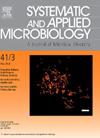Taxonomic and metabolic diversity of microbial communities in a thermal water stream in Uzbekistan and proposal of two new classes of uncultivated bacteria, Desulfocorpusculia class. nov. and Tepidihabitantia class. nov., named following the rules of SeqCode
IF 4.2
2区 生物学
Q2 BIOTECHNOLOGY & APPLIED MICROBIOLOGY
引用次数: 0
Abstract
Thermal ecosystems in Uzbekistan remain poorly characterized, particularly through culture-independent approaches. In this study, we performed 16S rRNA gene metabarcoding and metagenomic sequencing of microbial communities from a hot stream formed by the discharge of thermal artesian groundwater in the Navoiy region. The taxonomic composition of microbial communities varied with temperature and sample type, with the phylum Chloroflexota abundant in most samples. Members of Aquificota, Deinococcota, and Thermotogota dominated in sediments with temperatures around 60 °C, while Desulfobacterota and Cyanobacteriota were more abundant at lower temperatures. Metagenomic sequencing of the microbial community in sediment under orange-brown mat (54 °C) revealed a dominance of the phyla Chloroflexota, Armatimonadota, Aquificota, Ignavibacteriota, Desulfobacterota and Bacteroidota. Metagenomic data indicated that fermentation, aerobic degradation of organic matter, hydrogen oxidation, and sulfur cycling are the main metabolic processes. Two high-quality metagenome-assembled genomes (MAGs) were described as novel taxa named following the rules of SeqCode. Genome analysis suggests that both organisms are heterotrophic anaerobes capable of sulfate reduction or fermentation. We provide the description of Desulfocorpusculum asiaticumTs gen. nov., sp. nov. affiliated with the novel family Desulfocorpusculaceae fam. nov., order Desulfocorpusculales ord. nov. and class Desulfocorpusculia class. nov.; and the description of the new species and genus Tepidihabitans asiaticusTs gen. nov., sp. nov. affiliated with the novel family Tepidihabitantaceae fam. nov., order Tepidihabitantales ord. nov. and class Tepidihabitantia class. nov.
乌兹别克斯坦热水中微生物群落的分类和代谢多样性及两种未培养细菌——Desulfocorpusculia类的提出。十一月和暖地类。11、按照SeqCode规则命名
乌兹别克斯坦的热生态系统特征仍然很差,特别是通过与文化无关的方法。在这项研究中,我们对纳瓦伊地区热自流地下水排放形成的热流中的微生物群落进行了16S rRNA基因元条形码和宏基因组测序。微生物群落的分类组成随温度和样品类型的不同而变化,大多数样品中含有丰富的氯氟门。在60°C左右的温度下,Aquificota、Deinococcota和Thermotogota在沉积物中占主导地位,而Desulfobacterota和Cyanobacteriota在较低温度下更为丰富。橙棕垫(54°C)沉积物微生物群落元基因组测序结果显示,Chloroflexota、Armatimonadota、Aquificota、Ignavibacteriota、Desulfobacterota和Bacteroidota占主导地位。宏基因组数据表明,发酵、有机物好氧降解、氢氧化和硫循环是主要的代谢过程。两个高质量的宏基因组组装基因组(MAGs)被描述为按照SeqCode规则命名的新分类群。基因组分析表明,这两种生物都是异养厌氧菌,能够硫酸盐还原或发酵。我们提供了新家族Desulfocorpusculaceae fam的Desulfocorpusculum asiaticumTs gen. nov., sp. nov.的描述。11月,订购Desulfocorpusculales, 11月,分类Desulfocorpusculia类。11月;新科Tepidihabitans asiaticussts gen. nov., sp. nov.属的描述。11月,火蚁目和火蚁纲。11月。
本文章由计算机程序翻译,如有差异,请以英文原文为准。
求助全文
约1分钟内获得全文
求助全文
来源期刊

Systematic and applied microbiology
生物-生物工程与应用微生物
CiteScore
7.50
自引率
5.90%
发文量
57
审稿时长
22 days
期刊介绍:
Systematic and Applied Microbiology deals with various aspects of microbial diversity and systematics of prokaryotes. It focuses on Bacteria and Archaea; eukaryotic microorganisms will only be considered in rare cases. The journal perceives a broad understanding of microbial diversity and encourages the submission of manuscripts from the following branches of microbiology:
 求助内容:
求助内容: 应助结果提醒方式:
应助结果提醒方式:


